Biography
Arator was probably of Ligurian origin. An orphan, he studied at Milan under the patronage of the Bishop Laurentius and of Magnus Felix Ennodius, then went to Ravenna by the advice of Parthenius, nephew of Ennodius. He took up the career of a lawyer. [1]
Treated with distinction by Theodoric on account of his oration in behalf of the Dalmatians, and protected by Cassiodorus, he spent much of his career in Ravenna, doing the Gothic state some service with the fruits of a classical education second to none in what until recently had been the Western Roman Empire. It may have been the death of King Theoderic, and the destabilizing of the Gothic regime, that caused Arator to leave Ravenna (in this the career of Cassiodorus is parallel) and make for Rome. Pope Vigilius made him Subdeacon of the Roman Church. It was there that he wrote in hexameters two books De Actibus Apostolorum, about 544. [1] His gratitude to Vigilius, as expressed in a short poetic letter that dedicates the poem to him, shows notable warmth, and admiration of the see of Peter, and especially the apostle himself, together with strong animosity against the Goths—or at least their Arianism—is very clear in the poem.
Arator follows the story of the Acts of the Apostles; the first book, dedicated to St. Peter, concludes with Chapter XII; the second, dedicated to St. Paul, with the martyrdom of the two Apostles. Many important events are omitted, others only alluded to. Arator’s method in distilling Acts into epic verse is to select what he sees as its most important events, and to mould each of these into short episodes in which there is a simple, edifying, narrative or theme. Exegesis, often presented in homiletic fashion and invariably elaborated by formal rhetoric, is nowhere absent, but Arator gives formal exegesis greater weight than his predecessors had, by adding to almost every episode a kind of exegetical excursus, of equal or often greater length. Such a passage may present an issue arising directly from the text of Acts, or go beyond it to explore a particular feature. Arator’s fascination with allegory and obvious delight in exploring allegorical significance of themes, names, and numbers gives his work a wide perspective, as he ranges through Scripture and draws on material at first sight extraneous to Acts.
Arator's style and versification are fairly correct, [1] and he cleverly evades the entanglements of symbolism. The poem was very successful. Vigilius had the author read it in public at the church of San Pietro in Vincoli in Rome. The reading lasted four days, as the poet had to repeat many passages by request of his audience. The euphoria of the occasion, and the poem, was soon to be succeeded by more stressful times, and it may be that the author died within a few years, perhaps when the Goths sacked Rome in 546.
Arator's works remained popular during the Middle Ages, when they became classics, being eclipsed as curriculum texts only in the 12th century. He also wrote two addresses in distichs written by Arator to the Abbot Florianus and to Vigilius, as well as a letter to Parthenius. The latter two pieces contain biographical details.
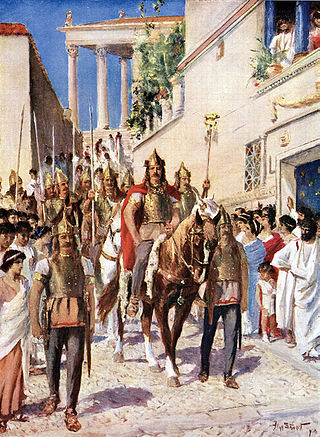
Alaric I was the first king of the Visigoths, from 395 to 410. He rose to leadership of the Goths who came to occupy Moesia—territory acquired a couple of decades earlier by a combined force of Goths and Alans after the Battle of Adrianople.

Amalasuintha was a ruler of the Ostrogothic Kingdom from 526 to 535. Initially serving as regent for her son Athalaric, she became queen after his premature death. Highly educated, Amalasuintha was praised by both Cassiodorus and Procopius for her wisdom and her ability to speak three languages. Her status as an independent female monarch, and obvious affinity for Roman culture, caused discontent among the Gothic nobles in her court, and she was deposed and killed after six months of sole rule.

Jordanes, also written as Jordanis or Jornandes, was a 6th-century Eastern Roman bureaucrat widely believed to be of Gothic descent who became a historian later in life. Late in life he wrote two works, one on Roman history (Romana) and the other on the Goths (Getica). The latter, along with Isidore of Seville's Historia Gothorum, is one of only two extant ancient works dealing with the early history of the Goths.

The Ostrogoths were a Roman-era Germanic people. In the 5th century, they followed the Visigoths in creating one of the two great Gothic kingdoms within the Roman Empire, based upon the large Gothic populations who had settled in the Balkans in the 4th century, having crossed the Lower Danube. While the Visigoths had formed under the leadership of Alaric I, the new Ostrogothic political entity which came to rule Italy was formed in the Balkans under the influence of the Amal dynasty, the family of Theodoric the Great.

Theodoricthe Great, also called Theodoric the Amal, was king of the Ostrogoths (475–526), and ruler of the independent Ostrogothic Kingdom of Italy between 493 and 526, regent of the Visigoths (511–526), and a patrician of the Eastern Roman Empire. As ruler of the combined Gothic realms, Theodoric controlled an empire stretching from the Atlantic Ocean to the Adriatic Sea. Though Theodoric himself only used the title 'king' (rex), some scholars characterize him as a Western Roman Emperor in all but name, since he ruled large parts of the former Western Roman Empire, had received the former Western imperial regalia from Constantinople in 497, and was referred to by the title augustus by some of his subjects.
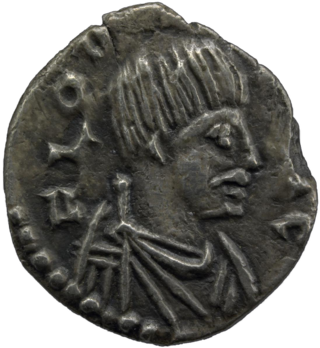
Odoacer, also spelled Odovacer or Odovacar, was a barbarian soldier and statesman from the Middle Danube who deposed the Western Roman child emperor Romulus Augustulus and became the ruler of Italy (476–493). Odoacer's overthrow of Romulus Augustulus is traditionally seen as marking the end of the Western Roman Empire.

Pope Symmachus was the bishop of Rome from 22 November 498 to his death. His tenure was marked by a serious schism over who was elected pope by a majority of the Roman clergy.
Pope Vigilius was the bishop of Rome from 29 March 537 to his death. He is considered the first pope of the Byzantine papacy. Born into Roman aristocracy, Vigilius served as a deacon and papal apocrisiarius in Constantinople. He allied with Empress Theodora, who sought his help to establish Monophysitism, and was made pope after the deposition of Silverius. After he refused to sign Emperor Justinian I's edict condemning the Three Chapters, Vigilius was arrested in 545 and taken to Constantinople. He died in Sicily while returning to Rome.
Claudius Claudianus, known in English as Claudian, was a Latin poet associated with the court of the Roman emperor Honorius at Mediolanum (Milan), and particularly with the general Stilicho. His work, written almost entirely in hexameters or elegiac couplets, falls into three main categories: poems for Honorius, poems for Stilicho, and mythological epic.

Magnus Aurelius Cassiodorus Senator, commonly known as Cassiodorus, was a Christian, Roman statesman, renowned scholar of antiquity, and writer serving in the administration of Theodoric the Great, king of the Ostrogoths. Senator was part of his surname, not his rank. He also founded a monastery, Vivarium, where he worked extensively the last three decades of his life.

De origine actibusque Getarum, commonly abbreviated Getica, written in Late Latin by Jordanes in or shortly after 551 AD, claims to be a summary of a voluminous account by Cassiodorus of the origin and history of the Gothic people, which is now lost. However, the extent to which Jordanes actually used the work of Cassiodorus is unknown. It is significant as the only remaining contemporaneous resource that gives an extended account of the origin and history of the Goths, although to what extent it should be considered history or origin mythology is a matter of dispute.
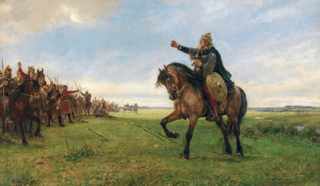
Hlöðskviða, known in English as The Battle of the Goths and Huns and occasionally known by its German name Hunnenschlachtlied, is an Old Norse heroic poem found in Hervarar saga ok Heiðreks. Many attempts have been made to try to fit it with known history, but it is an epic poem, telescoping and fictionalising history to a large extent; some verifiable historical information from the time are place names, surviving in Old Norse forms from the period 750–850, but it was probably collected later in Västergötland.
Parthenius of Nicaea or Myrlea in Bithynia was a Greek grammarian and poet. According to the Suda, he was the son of Heraclides and Eudora, or according to Hermippus of Berytus, his mother's name was Tetha. He was taken prisoner by Helvius Cinna in the Mithridatic Wars and carried to Rome in 72 BC. He subsequently visited Neapolis, where he taught Greek to Virgil, according to Macrobius. Parthenius is said to have lived until the accession of Tiberius in 14 AD.
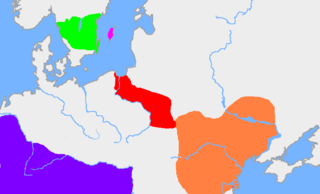
Oium was a name for Scythia, or a fertile part of it, roughly in modern Ukraine, where the Goths, under a legendary King Filimer, settled after leaving Gothiscandza, according to the Getica by Jordanes, written around 551.
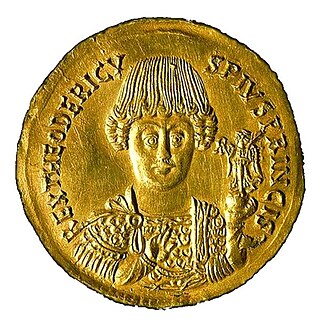
The Ostrogothic Kingdom, officially the Kingdom of Italy, existed under the control of the Germanic Ostrogoths in Italy and neighbouring areas from 493 to 553.
Gaius Vettius Aquilinus Juvencus was a Roman Christian poet from Hispania who wrote in Latin.
Petrus Marcellinus Felix Liberius was a Late Roman aristocrat and official, whose career spanned seven decades in the highest offices of both the Ostrogothic Kingdom of Italy and the Eastern Roman Empire. He held the highest governmental offices of Italy, Gaul, and Egypt, "an accomplishment not often recorded – Caesar and Napoleon Bonaparte are the only parallels that come to mind!" as James O'Donnell observes in his biographical study of the man.
Eutharic Cilliga was an Ostrogothic prince from Iberia who, during the early 6th century, served as Roman Consul and "son in weapons" alongside the Byzantine emperor Justin I. He was the son-in-law and presumptive heir of the Ostrogoth king Theodoric the Great but died in AD 522 at the age of 42 before he could inherit Theodoric's title. Theodoric claimed that Eutharic was a descendant of the Gothic royal house of Amali and it was intended that his marriage to Theodoric's daughter Amalasuintha would unite the Gothic kingdoms, establish Theodoric's dynasty and further strengthen the Gothic hold over Italy.
Ostrogothic Ravenna refers to the time period in which Ravenna, a city in Northeastern Italy, served as the capital of the Ostrogothic Kingdom, which existed between 493 and 553 CE. During that time, Ravenna saw a great renovation, in particular under Theodoric the Great (454–526). During his rule, Ravenna saw many of its finest monuments constructed or renovated, including the Basilica of Sant'Apollinare Nuovo, the Palace of Theoderic, and Mausoleum of Theodoric. Many of these monuments reflect the Arian faith of Theodoric and the Goths. Though an Arian Christian himself, Theodoric's rule was a time of religious tolerance in the city of Ravenna. His religious tolerance extended also to forging a balance between the Romans and Goths in Ravenna. Theodoric attempted to model Ravenna as a capital equivalent to that of Rome or Constantinople and as such was a defender of classical antiquity in a western world that saw much of its classical heritage disappearing.











